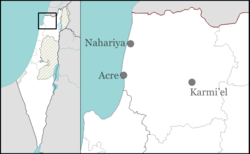Shtula: Difference between revisions
+image |
+data |
||
| Line 26: | Line 26: | ||
The village was the site of [[Hezbollah]]'s [[2006 Hezbollah cross-border raid|cross-border raid]] in the [[2006 Lebanon War]], in which three Israeli soldiers were killed and two captured.{{cn|date=October 2019}} |
The village was the site of [[Hezbollah]]'s [[2006 Hezbollah cross-border raid|cross-border raid]] in the [[2006 Lebanon War]], in which three Israeli soldiers were killed and two captured.{{cn|date=October 2019}} |
||
In 2014, a resident of Shtula alerted the Hebrew University Cave Research Unit to a deep cave near the moshav. The researchers declared it a record for Israel at 187-meters deep.<ref>[https://www.israel21c.org/researchers-map-israels-deepest-cave/ Mapping Israel’s deepest cave]</ref> |
|||
==References== |
==References== |
||
Revision as of 11:24, 15 October 2023
Shtula
שְׁתוּלָה | |
|---|---|
 | |
| Etymology: "Planted" | |
| Coordinates: 33°5′8″N 35°18′47″E / 33.08556°N 35.31306°E | |
| Country | |
| District | Northern |
| Council | Ma'ale Yosef |
| Affiliation | Moshavim Movement |
| Founded | 1967 |
| Founded by | Galilee moshavniks |
| Population (2022)[1] | 311 |
| Website | www.shtula.org.il |
Shtula (Hebrew: שְׁתוּלָה, lit. Planted) is a moshav in northern Israel. Located in the Upper Galilee near the Lebanese border, it falls under the jurisdiction of Ma'ale Yosef Regional Council. In 2022 it had a population of 311.[1]
History
The moshav was established in 1967 by moshav residents from the Galilee as part of Operation Sof Sof, designed to strengthen Jewish presence in the Galilee. Its name is symbolic and has a similar meaning to that of nearby Netu'a.[citation needed] Many residents originated from the town of Koy Sanjaq in Iraq and children in the moshav used to learn Koy Sanjaq Jewish Neo-Aramaic.[2]
The moshav is located on the land of the Palestinian villages of Suruh and Tarbikha, which were depopulated in the 1948 Arab–Israeli War.[3]
The village was the site of Hezbollah's cross-border raid in the 2006 Lebanon War, in which three Israeli soldiers were killed and two captured.[citation needed]
In 2014, a resident of Shtula alerted the Hebrew University Cave Research Unit to a deep cave near the moshav. The researchers declared it a record for Israel at 187-meters deep.[4]
References
- ^ a b "Regional Statistics". Israel Central Bureau of Statistics. Retrieved 21 March 2024.
- ^ Hoberman, Robert D. (1985). "The Phonology of Pharyngeals and Pharyngealization in Pre-Modern Aramaic". Journal of the American Oriental Society. 105 (2): 221–231. doi:10.2307/601702. ISSN 0003-0279.
- ^ Khalidi, W. (1992). All That Remains: The Palestinian Villages Occupied and Depopulated by Israel in 1948. Washington D.C.: Institute for Palestine Studies. pp. 32, 34. ISBN 0-88728-224-5.
- ^ Mapping Israel’s deepest cave
External links
- Official website (in Hebrew)


